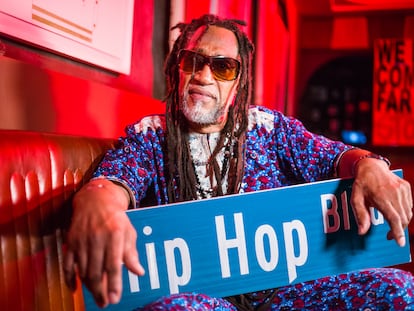They were bandmates and burned churches, until one killed the other: The crime that marked black metal
Together, they unleashed a wave of extremism and madness. Then, on the night of August 10, 1993, Norwegian neo-Nazi Varg Vikernes stabbed Euronymous, his cohort and guitar player in the band Mayhem, 23 times

If you type “black metal” in the GIF search bar of WhatsApp, one of the first results that you will see is the image of a young blue-eyed man in his twenties with long hair, looking back at the camera and slowly forming a smile, with the air of someone who has just pulled a prank. In truth, this is his reaction to the reading of the sentence that in 1994 sent him to prison for 21 years for one of the most famous murders of the extreme metal scene: a Norwegian-born genre marked by a hard sound with a hyper-accelerated rhythm, anti-Christian lyrics and a good dose of violence.
The criminal in question is Varg Vikernes (née Kristian), also known as Count Grishnackh (the name of an orc from The Lord of the Rings), and the victim was the leader of the band Mayhem, guitar player Øystein Aarseth (aka Euronymous), a key figure known for the birth and establishment of black metal in the Scandinavian country. A musical affinity had emerged between the two, based on the contempt they felt for what they considered modern society. Together, they went from being togther in a band to being together in church-burning terrorist group. Later, that anger would escalate into an irreparable mutual hatred.
“In 1991, most of the metal musicians in Norway believed Euronymous was a so-called cool guy, but in mid or late 1992 most of us realized that he was not,” writes Vikernes on his official website. Necrobutcher, one of the founders and current bassist of Mayhem, was among the first to distance himself from the guitar player, upset by the way he reacted to the suicide of Mayhem singer, Per Yngve Ohlin, aka Dead (suffering from Cotard syndrome, a delusional denial of existence, Ohlin used that nickname because he considered himself to be dead).
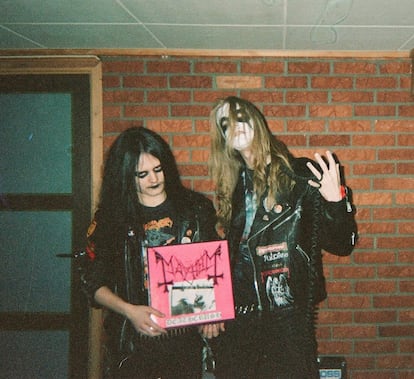
Ohlin had radically changed the image of Mayhem and black metal: he was one of the first to introduce face paint and took his concerts to another level with feats like slashing his arms with a knife and a broken bottle live on stage. The band’s first drummer accused Euronymous of taking advantage of Dead’s psychiatric condition to push him to suicide, which took place on April 8, 1991. That day, the singer slit his throat and the veins in his wrists and shot himself in the head, leaving a note with the message “Excuse the blood” and the lyrics of what would become the Mayhem song Life Eternal. When he arrived at the scene, before notifying the police, Euronymous took some photos. One of them became the cover of the live album Dawn of the Black Hearts (1995). Pieces of the skull were distributed as relics to other musicians and used for necklaces.
In 2019, Necrobutcher stated that he was so angry that he was planning to kill Euronymous himself, but Vikernes beat him to it. The episode helped fuel the band’s fame and radicalize the movement. Euronymous also owned a label, Deathlike Silence Productions, home of the new promises of black metal. Among them was Burzum, Vikernes’ project, who at the beginning of 1991 sent two demos that earned him an invitation to Oslo and a record contract. Shortly after, he fulfilled the biggest aspiration that a fan of the genre could have had at the time: replacing Necrobutcher and recording bass for the Mayhem masterpiece De Mysteriis Dom Sathanas (1994).
Hell
Between May and June 1991, Euronymous opened the record store Helvete (hell, in English) in the Gamlebyen neighborhood of Oslo. Some of the most important members of the black metal scene used to meet in the basement, such as Snorre Ruch (Blackthorn), Bård Eithun (Faust) and Varg Vikernes himself. It is in this context that the Black Circle took shape (referred to by the press as the Black Metal Mafia), which burned churches and desecrated cemeteries.
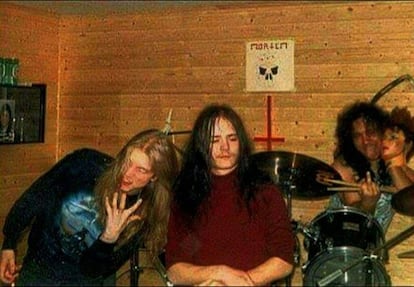
Vikernes, who always denied the group’s existence, considered these acts legitimate for different reasons than his peers. His faith was oriented towards a belief system known as Odalism, a neopagan creed characterized by a combination of religion and race, and only declared himself a Satanist for the aesthetics. Churches, in his view, had to be destroyed because they stood on ancient pagan temples and because Christianity had uprooted the ancient religion of the Vikings. In 1992, 52 places of worship were burned and 15,000 graves desecrated, the remains of which adorned the walls of Helvete. Of the structures that were destroyed, the most famous was the stavkirke (a medieval stave church) of Fantoft, near Bergen. The group was planning to murder a passerby for that attack, but due to the late hour, they decided to leave a decapitated rabbit in the place, instead. The victim would come in another fire, that of Sarpsborg, where a firefighter died.
Heavy metal bands considered by the Black Circle to be trend followers also ended up in their sights. In July 1992, a militant named Maria doused acetone on the door and windows of the house of the Swede Christopher Johnsson, leader of the band Therion, with a message on the front door: “The Count [as Vikernes called himself] was here, and he will return.” Johnsson was spared, but he received a letter apparently written by Vikernes: “Hello victim! This is Count Grishnackh of Burzum. I have just come home from a journey to Sweden and I think I lost a match and a signed Burzum LP, ha ha! Perhaps I will make a return trip soon and maybe this time you won’t wake up in the middle of the night.”
Around this time, relations between Euronymous and Vikernes began to turn sour. The latter had his own new material to publish, but the manager kept giving him the runaround and did not return the approximately $5,000 he had paid as an advancement for his first album, the homonymous Burzum (1992). Euronymous, according to Vikernes, was using it to pay off his debts. “All he did was to sit on his fat arse in his shop and drink Coca Cola and eat kebab,” he writes.
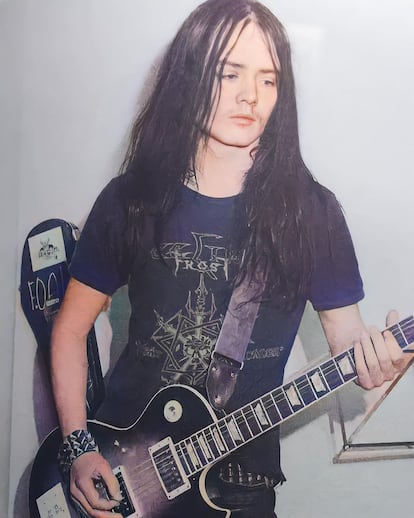
The break was made definitive with an article published in the Bergens Tidende newspaper in January 1993. It was an interview with Varg Vikernes as his alter ego Count Grishnackh, where he declared himself responsible for the burning of churches and the murder of a homosexual man in Lillehammer. For that murder, another member of the Black Circle, Faust, was sentenced to 14 years in jail. The journalist alerted the police before the front-page publication, which had the headline “We lit the fires” and a photo of Vikernes with two daggers in his hand and his face almost completely covered by hair. “I exaggerated a lot and when the journalist left we — a girl and I v had a good laugh, because he didn’t seem to understand that I was pulling his leg,” he says on his website. The police tracked him down two days later and he spent six months in pretrial detention, until he was released for lack of evidence.
Vikernes gave the interview with the aim of resurrecting Helvete. However, the uproar caused Euronymous to close the store: “The interesting thing is that when I was arrested Euronymous closed down the shop instead of taking advantage of the situation, because his parents thought the attention was too uncomfortable! [...] Pretty pathetic, alright,” he says on his blog, before calling him “a damn wimp and an idiot.”
Death
For some, there was a political motive behind the murder of Euronymous: the Mayhem leader had communist ideas and believed in Satanism, while Varg Vikernes followed neo-Nazi postulates and racist religious beliefs. Another theory is that he hated his victim because he was of Lappish origin and did not consider him truly Norwegian. Weeks before the crime, he claimed that Euronymous was homosexual.
Meanwhile, for Vikernes, the murder was legitimate defense. According to him, Euronymous was conspiring to kill him, as he blamed him for his declining popularity. “Varg must disappear for good,” the leader of Mayhem allegedly told Snorre Ruch, before explaining his plan to knock him out with a stun gun, tie him up and torture him to death.
At 9 p.m. on August 9, 1993, Varg Vikernes left Bergen with the alleged intention to show up at Euronymous’ house to “hand him the signed contract and tell him to fuck off.” He was accompanied by Blackthorn himself, who had prepared some riffs for his colleague from Mayhem to listen to. Once there, Blackthorn stayed in the attic smoking and Vikernes went into Euronymous’ apartment. At that moment — always according to his own reconstruction — he asked him: “What do you want from me, you Lappish communist? Why do you want to kill me?”
Euronymous kicked him and ran into the kitchen, presumably to arm himself with a knife. Vikernes pulled out a dull three-inch blade and plunged it into his back, prompting his victim to try to call the neighbors for help. In total he received 23 stab wounds, including a fatal one in his head, although the murderer maintains that some of the injuries occurred when he fell on the pieces of a broken lamp. Euronymous’ body ended up on the stairs; he was wearing nothing but his underwear.
Vikernes disposed of the bloody clothes by tying them to stones and throwing them into a lake. He got himself an alibi implicating his friend Andreas Nagelsett, who rented some movies using Blackthorn’s credit card to make it look like the duo had never left Bergen. However, Blackthorn broke down and told the police everything. After that, the story gets confusing. Vikernes says that for some reason Blackthorn made up a story, stating that they had planned everything from the beginning. He also calls attention to some of the jurors, two for being “Freemasons,” one for being an “Auschwitz survivor” and one court psychiatrist for being a “left-wing extremist.”
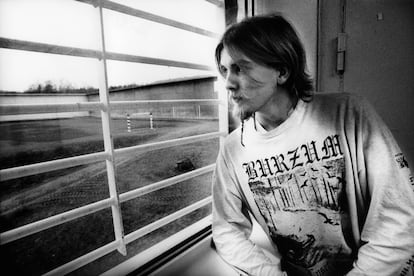
Vikernes maintained that he had not gone there with the intent to kill. However, inside his car they found three knives, a baseball bat, a bayonet and an axe. He was sentenced to 21 years in prison, the maximum sentence in Norway, for the murder of Euronymous, the burning of three churches and the possession of 330 pounds of explosives. Blackthorn, despite having played no role in the murder according to Vikernes, was sentenced to eight years as an accessory. Following the incident, the mother of the former Mayhem frontman asked the band’s drummer, Hellhammer, to remove the bass parts that her son’s killer had recorded for De Mysteriis Dom Sathanas. He, however, says that they only removed his name from the credits.
After the murder
In prison, Vikernes continued to compose music for Burzum, but no one was willing to release the records of a die-hard Nazi murderer, until the German music journalist Tiziana Stupia published his work under the Mysanthropy Records label. Since then, in addition to several records, Vikernes has published books in which he elaborates on his views on life, racial segregation, paganism and politics. In 2003, he failed to report to jail after being granted a short release; he was found on an Oslo highway driving a stolen car and threatening a family. He claimed he had escaped because someone wanted to kill him. His release was scheduled for 2006, but he was not paroled until 2009.
Two years later, he was one of the 530 supporters who received the manifesto of terrorist Anders Breivik before the Oslo and Utoya massacres, where 77 people were killed. On his website, Vikernes criticized the terrorist for not having attacked “the real target,” the Jews, and scorned the victims: “How can they be so extremely cowardly and impotent? Any sane person would at least try to react in a situation like that. Even after seven stab wounds and with punctured lungs, [Euronymous] fought back.”
In 2013, he was arrested in France, along with his wife, for allegedly planning another massacre. Although he was exonerated, he was sentenced to six months on probation and had to pay a fine of €8,000 ($8,750) for inciting hatred and disseminating racist and anti-Semitic material. These ideas were an essential part of his YouTube videos, an account that the company deleted in 2019. Swedish director and drummer Jonas Åkerlund told the story of Euronymous, Vikernes and the Black Circle in the film Lords of Chaos (2018), based on the homonymous book by Michael Moynihan and Didrik Søderlind. Vikernes called it “trash” without seeing it, upset by the Jewish ancestry of the actor who played him, Emory Cohen. Today, he is still free. As for Mayhem, the band is still active with two of the original members, Hellhammer and Necrobutcher.
Sign up for our weekly newsletter to get more English-language news coverage from EL PAÍS USA Edition
Tu suscripción se está usando en otro dispositivo
¿Quieres añadir otro usuario a tu suscripción?
Si continúas leyendo en este dispositivo, no se podrá leer en el otro.
FlechaTu suscripción se está usando en otro dispositivo y solo puedes acceder a EL PAÍS desde un dispositivo a la vez.
Si quieres compartir tu cuenta, cambia tu suscripción a la modalidad Premium, así podrás añadir otro usuario. Cada uno accederá con su propia cuenta de email, lo que os permitirá personalizar vuestra experiencia en EL PAÍS.
¿Tienes una suscripción de empresa? Accede aquí para contratar más cuentas.
En el caso de no saber quién está usando tu cuenta, te recomendamos cambiar tu contraseña aquí.
Si decides continuar compartiendo tu cuenta, este mensaje se mostrará en tu dispositivo y en el de la otra persona que está usando tu cuenta de forma indefinida, afectando a tu experiencia de lectura. Puedes consultar aquí los términos y condiciones de la suscripción digital.
More information
Archived In
Últimas noticias
There is as much life left to discover on planet Earth as that which is already known
Dozens presumed dead, around 100 injured in fire at Swiss Alps bar during New Year’s celebration
Is porn for women different from conventional porn? We spoke to those who make it
Cartagena de Indias is sinking: What can the city do to mitigate it?
Most viewed
- Sinaloa Cartel war is taking its toll on Los Chapitos
- Reinhard Genzel, Nobel laureate in physics: ‘One-minute videos will never give you the truth’
- Oona Chaplin: ‘I told James Cameron that I was living in a treehouse and starting a permaculture project with a friend’
- David King, chemist: ‘There are scientists studying how to cool the planet; nobody should stop these experiments from happening’
- Why the price of coffee has skyrocketed: from Brazilian plantations to specialty coffee houses
